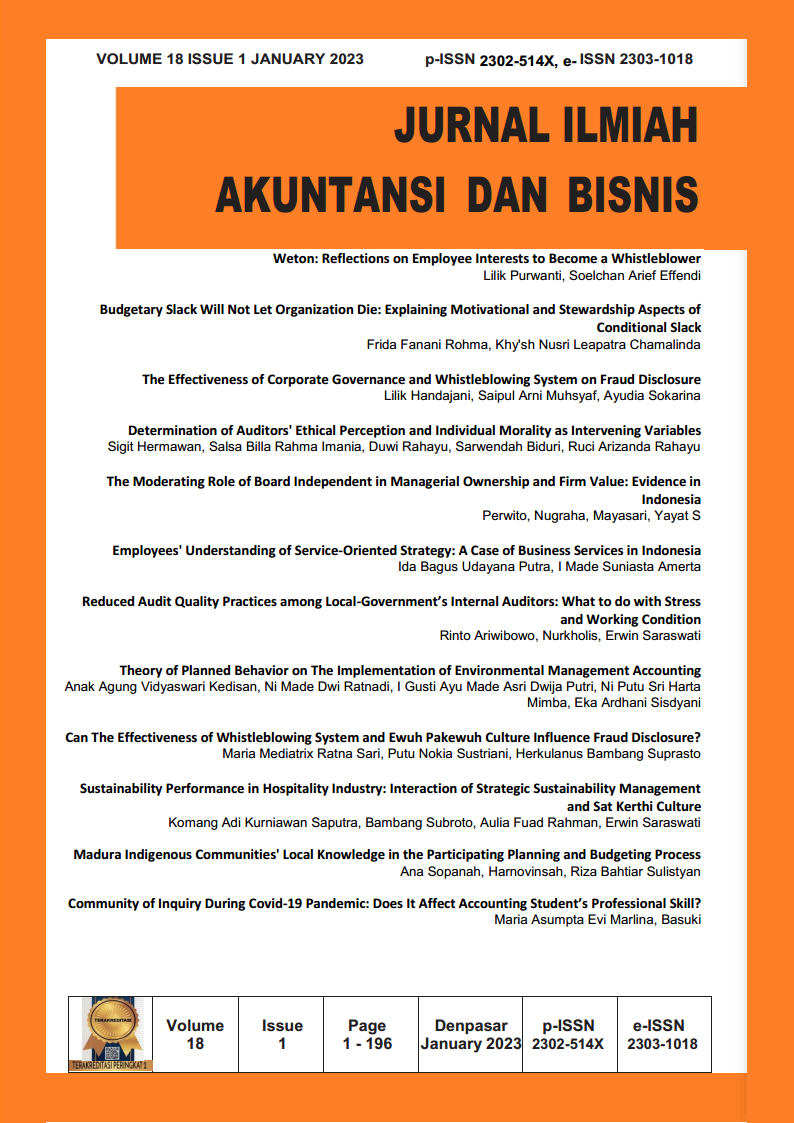Interacting Roles of Executive Compensation on Organizational Slack and Firm’s Innovation Performance
Abstract
This study examines the interaction between executive compensation and three types of organizational slack (available, recoverable, and potential) and their impact on the innovation performance of publicly listed companies in Indonesia. The empirical analysis use a dataset of 1,081 firm-year observations from 2010 to 2019. The findings reveal that available slack positively affects innovation performance, whereas recoverable and potential slack have negative impacts. Executive compensation significantly moderates these relationships, especially nullifying the negative impact of recoverable slack on innovation. The results highlight the importance of strategic management and the role of executive compensation in enhancing a firm's innovation, offering valuable insights for shareholders and contributing to the understanding of organizational slack and compensation's effect on innovation in the Indonesian context.
Keywords: organizational slack, executive compensation, innovation, innovation performance, Indonesia
Downloads
References
Alrashdan, A., & Alnahedh, M. (2023). Slack resources and firm performance: evidence from GCC countries. International Journal of Organizational Analysis, 31(7), 3348–3371.
Bartolini, E. (2013). Accountable Care Organizations and Innovation: A Changing Landscape. Health Affairs Blog, June 28.
Birchall, D., Chanaron, J.-J., Tovstiga, G., & Hillenbrand, C. (2011). Innovation performance measurement: current practices, issues and management challenges. International Journal of Technology Management, 56(1), 1–20.
Bourgeois, L. J. (1981). On the Measurement of Organizational Slack. The Academy of Management Review, 6(1), 29–39. https://doi.org/10.2307/257138
Chari, M. D. R., David, P., Duru, A., & Zhao, Y. (2019). Bowman’s risk-return paradox: An agency theory perspective. Journal of Business Research, 95, 357–375. https://doi.org/https://doi.org/10.1016/j.jbusres.2018.08.010
Chen, J. K. C., Ho, Y.-S., Wang, M.-H., & Chen, Y.-Y. (2010). Evaluation innovation research performance and trend of the worldwide. PICMET 2010 TECHNOLOGY MANAGEMENT FOR GLOBAL ECONOMIC GROWTH, 1–13.
Chen, Y.-M., Yang, D.-H., & Lin, F.-J. (2013). Does technological diversification matter to firm performance? The moderating role of organizational slack. Journal of Business Research, 66(10), 1970–1975. https://doi.org/https://doi.org/10.1016/j.jbusres.2013.02.020
Cheng, J. L. C., & Kesner, I. F. (1997). Organizational slack and response to environmental shifts: The impact of resource allocation patterns. Journal of Management, 23(1), 1–18. https://doi.org/https://doi.org/10.1016/S0149-2063(97)90003-9
Core, J. E., Guay, W., & Larcker, D. F. (2008). The power of the pen and executive compensation. Journal of Financial Economics, 88(1), 1–25. https://doi.org/https://doi.org/10.1016/j.jfineco.2007.05.001
Daniel, F., Lohrke, F. T., Fornaciari, C. J., & Turner, R. A. (2004). Slack resources and firm performance: a meta-analysis. Journal of Business Research, 57(6), 565–574. https://doi.org/https://doi.org/10.1016/S0148-2963(02)00439-3
DeFond, M. L., Erkens, D. H., & Zhang, J. (2016). Does PSM Really Eliminate the Big N Audit Quality Effect? Marshall School of Business Working Paper No. ACC 02.14. https://doi.org/https://dx.doi.org/10.2139/ssrn.2472092
Duan, Y., Wang, W., & Zhou, W. (2020). The multiple mediation effect of absorptive capacity on the organizational slack and innovation performance of high-tech manufacturing firms: Evidence from Chinese firms. International Journal of Production Economics, 229, 107754. https://doi.org/https://doi.org/10.1016/j.ijpe.2020.107754
Finkelstein, S., & Hambrick, D. C. (1997). Strategic Leadership: Top Executive and Their Effects on Organizations. The Academy of Management Review, 22(3), 802–805.
Geiger, S. W., & Cashen, L. H. (2002). A Multidimensional Examination Of Slack And Its Impact On Innovation. Journal of Managerial Issues, 14(1), 68–84.
Geiger, S. W., & Makri, M. (2006). Exploration and exploitation innovation processes: The role of organizational slack in R&D intensive firms. The Journal of High Technology Management Research, 17(1), 97–108.
Hadley, B. (2019). Executive compensation and political sensitivity: Evidence from government contractors. Journal of Corporate Finance, 59, 276–301. https://doi.org/https://doi.org/10.1016/j.jcorpfin.2016.11.007
Harymawan, I. (2020). Military reform, militarily-connected firms and auditor choice. Managerial Auditing Journal, 35(6), 705–729. https://doi.org/10.1108/MAJ-04-2019-2258
Herold, D. M., Jayaraman, N., & Narayanaswamy, C. R. (2006). What is the Relationship between Organizational Slack and Innovation? Journal of Managerial Issues, 18(3), 372–392.
Jensen, M. C., & Meckling, W. H. (1976). Theory of the firm: Managerial behavior, agency costs and ownership structure. In Corporate governance (pp. 77–132). Gower.
Kolluru, S., & Mukhopadhaya, P. (2017). Empirical studies on innovation performance in the manufacturing and service sectors since 1995: A systematic review. Economic Papers: A Journal of Applied Economics and Policy, 36(2), 223–248.
Laffranchini, G., & Braun, M. (2014). Slack in family firms: evidence from Italy (2006-2010). Journal of Family Business Management, 4(2), 171–193. https://doi.org/https://doi.org/10.1108/JFBM-04-2013-0011
Lee, S. (2015). Slack and innovation: Investigating the relationship in Korea. Journal of Business Research, 68(9), 1895–1905. https://doi.org/https://doi.org/10.1016/j.jbusres.2014.12.009
Leitner, J., & Meyer, M. (2013). Organizational Slack and Innovation BT - Encyclopedia of Creativity, Invention, Innovation and Entrepreneurship (E. G. Carayannis (ed.); pp. 1412–1419). Springer New York. https://doi.org/10.1007/978-1-4614-3858-8_318
Li, L. (2013). The path to Made-in-China: How this was done and future prospects. International Journal of Production Economics, 146(1), 4–13. https://doi.org/https://doi.org/10.1016/j.ijpe.2013.05.022
Liu, Y., Gan, H., & Karim, K. (2021). The effectiveness of chief financial officer board membership in improving corporate investment efficiency. In Review of Quantitative Finance and Accounting (Vol. 57, Issue 2). Springer US. https://doi.org/10.1007/s11156-020-00953-2
Marlin, D., & Geiger, S. W. (2015). A reexamination of the organizational slack and innovation relationship. Journal of Business Research, 68(12), 2683–2690. https://doi.org/https://doi.org/10.1016/j.jbusres.2015.03.047
Nohria, N., & Gulati, R. (1996). Is Slack Good or Bad for Innovation? The Academy of Management Journal, 39(5), 1245–1264. https://doi.org/10.2307/256998
Raithatha, M., & Komera, S. (2016). Executive compensation and firm performance: Evidence from Indian firms. IIMB Management Review, 28(3), 160–169. https://doi.org/https://doi.org/10.1016/j.iimb.2016.07.002
Shipman, J. E., Swanquist, Q. T., & Whited, R. L. (2017). Propensity Score Matching in Accounting Research. The Accounting Review, 92(1), 213–244. https://doi.org/https://doi.org/10.2308/accr-51449
Tan, J., & Peng, M. W. (2003). Organizational slack and firm performance during economic transitions: two studies from an emerging economy. Strategic Management Journal, 24(13), 1249–1263. https://doi.org/https://doi.org/10.1002/smj.351
Walker, R. M. (2004). Innovation and organisational performance: Evidence and a research agenda. Advanced Institute of Management Research Paper, 002.

This work is licensed under a Creative Commons Attribution-NonCommercial-ShareAlike 4.0 International License.




















